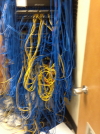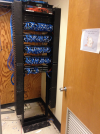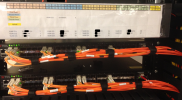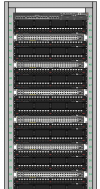NETWizz
Well-Known Member
- Reaction score
- 1,980
I wish I chimed in earlier. My suggestion is to NOT make this hard on yourself, which you are doing.
I do not know about those particular switches, but ensure you get switches that support stacking and setup one big stack if they are all in the same rack.
Wire it patch panel 2U, 1U switch, 1 U empty space.... and repeat, Use 1' jumper cables WITHOUT boots.
Now for the VOIP, search for an article I posted a few years ago about VLANS, but I highly suggest you NOT setup separate equipment for VoIP to make it easier because it will NOT be. Instead, setup separate VLANS ensuring each port has a data VLAN and a voice VLAN assigned. Each manufacturer does it differently. On Cisco Gear Voice VLAN sets an 802.1q tag and turns on CDP and LLDP-MED to identify that VLAN to the phones. I am NOT sure how Microtek works, but it is almost certainly the same. Anyway, the data VLAN is simple untagged layer-2 frames.
This will prevent calls for computers not working attached to VoIP ports and vice versa. Additionally, many phones have a built-in switch. You plug the phone into the wall port. Then you plug the computer into the switchport on the phone. The Phone joins the Voice VLAN on the Voice Network, and the computer joins the data network.
Regarding your Internet, how are you balancing two connections? Does that Meraki device balance it? Does it have any fiber transceiver slots? Does it serve as a firewall? Usually for Internet circuits I attach them to a dedicated firewall device. For a small network like this one, a Palo Alto PA 220 would be what I would spec.
I would HIGHLY recommend switches that fully support QoS as well all the way to the VoIP circuit. Regarding your VLANS I see you need four (4) most likely.
Data
Voice
Uplink to your Internet
Wireless
Now, if you have fiber Internet coming in direct fiber hand-off, you can create another VLAN and use it as a media converter.
I do not know about those particular switches, but ensure you get switches that support stacking and setup one big stack if they are all in the same rack.
Wire it patch panel 2U, 1U switch, 1 U empty space.... and repeat, Use 1' jumper cables WITHOUT boots.
Now for the VOIP, search for an article I posted a few years ago about VLANS, but I highly suggest you NOT setup separate equipment for VoIP to make it easier because it will NOT be. Instead, setup separate VLANS ensuring each port has a data VLAN and a voice VLAN assigned. Each manufacturer does it differently. On Cisco Gear Voice VLAN sets an 802.1q tag and turns on CDP and LLDP-MED to identify that VLAN to the phones. I am NOT sure how Microtek works, but it is almost certainly the same. Anyway, the data VLAN is simple untagged layer-2 frames.
This will prevent calls for computers not working attached to VoIP ports and vice versa. Additionally, many phones have a built-in switch. You plug the phone into the wall port. Then you plug the computer into the switchport on the phone. The Phone joins the Voice VLAN on the Voice Network, and the computer joins the data network.
Regarding your Internet, how are you balancing two connections? Does that Meraki device balance it? Does it have any fiber transceiver slots? Does it serve as a firewall? Usually for Internet circuits I attach them to a dedicated firewall device. For a small network like this one, a Palo Alto PA 220 would be what I would spec.
I would HIGHLY recommend switches that fully support QoS as well all the way to the VoIP circuit. Regarding your VLANS I see you need four (4) most likely.
Data
Voice
Uplink to your Internet
Wireless
Now, if you have fiber Internet coming in direct fiber hand-off, you can create another VLAN and use it as a media converter.




